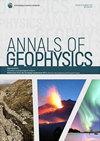Scintillation Climatology from a Software Defined Radio Receiver over Antarctica
IF 1.2
4区 地球科学
Q3 GEOCHEMISTRY & GEOPHYSICS
引用次数: 0
Abstract
Software-Defined Radio (SDR) Global Navigation Satellite System (GNSS) receivers for operational Ionospheric Scintillation Monitoring (ISM) have faced challenges and were deemed failures by many research projects. The need for a highly stable oscillator and a robust real-time signal-tracking capability have been the main challenges. The Istituto Nazionale di Geofisica e Vulcanologia (INGV) led a project called DemoGRAPE (Demonstrator of GNSS Research and Application for Polar Environment) to deploy an SDR GNSS Receiver in SANAE IV Antarctica station, which has been continuously operating since January 2016. The SDR receiver was designed by the Navigation Signal Analysis and Simulation (NavSAS) group in collaboration with the Joint Research Centre (JRC) of the European Commission. The system deploys the SDR in parallel to a Septentrio PolaRxS ISM receiver. The two receivers are fed by the same receiving antenna (i.e., they share the same field of view and, hence, cross the same portion of the ionosphere) such that they receive quasi-identical signals except for the independent effects of their front-ends. The SDR produces as output a log file, equivalent to the ISM record produced by PolaRxS, that contains the amplitude and phase scintillation indexes. In addition to this, the SDR system records the raw digital samples of the GNSS signal when the internal algorithm of the receiver detects scintillation presence. These data can be used to replicate the scintillation event in the laboratory and perform dedicated post-processing of the raw signal itself. The system has been in operation for over seven years now, spanning more than half a solar cycle. It has recorded several geomagnetic storm events as well as abundant data in quiet conditions. To the best of our knowledge, this is the longest dataset of this nature (co-located PolaRxS and SDR receivers). We compare the performance of the two receivers by analyzing the scintillation climatology maps obtainable from both receivers' data. Here, the climatology is obtained using the well-established Ground Based Scintillation Climatology (GBSC) technique from the data provided by the two different receivers. The study shows that the SDR climatology maps under disturbed geomagnetic conditions are equivalent to those obtained from the PolaRxS receiver. Under quiet conditions, the SDR shows more scintillation events than the PolaRxS. Carefully inspecting the differences in the scintillation occurrence between the two receivers, they seem not to happen randomly but mainly concentrated along the expected (climatological) position of the auroral oval. This means that the SDR application for space weather monitoring could be possible and that the SDR could be utilizable as an informative tool by the ionospheric scintillation community.南极上空软件无线电接收器的闪烁气候学研究
用于电离层闪烁监测(ISM)的软件定义无线电(SDR)全球导航卫星系统(GNSS)接收器面临挑战,许多研究项目都认为它是失败的。主要的挑战是需要一个高度稳定的振荡器和强大的实时信号跟踪能力。国家地球物理与火山学研究所(INGV)领导了一个名为DemoGRAPE(极地环境GNSS研究与应用示范)的项目,在SANAE IV南极站部署了一个SDR GNSS接收器,该接收器自2016年1月以来一直在持续运行。SDR接收器由导航信号分析与仿真(NavSAS)小组与欧盟委员会联合研究中心(JRC)合作设计。 该系统将SDR与Septentrio PolaRxS ISM接收机并行部署。两个接收器由相同的接收天线馈电(即它们共享相同的视场,因此穿过电离层的相同部分),这样,除了其前端的独立影响外,它们接收的信号基本相同。SDR 的输出是一个日志文件,相当于 PolaRxS 生成的 ISM 记录,其中包含振幅和相位闪烁指数。除此之外,当接收器的内部算法检测到闪烁存在时,SDR 系统还会记录 GNSS 信号的原始数字样本。这些数据可用于在实验室中复制闪烁事件,并对原始信号本身进行专门的后处理。该系统已经运行了七年多,跨越了半个多太阳周期。它记录了几次地磁暴事件以及安静条件下的大量数据。据我们所知,这是此类性质(共用 PolaRxS 和 SDR 接收器)的最长数据集。我们通过分析从两个接收器的数据中获得的闪烁气候图来比较两个接收器的性能。在这里,气候学是利用成熟的地基闪烁气候学(GBSC)技术从两个不同接收器提供的数据中获得的。 研究表明,地磁扰动条件下的 SDR 气候图与 PolaRxS 接收器获得的气候图相当。在安静条件下,SDR 比 PolaRxS 显示出更多的闪烁事件。仔细观察两台接收机发生闪烁的差异,它们似乎不是随机发生的,而是主要集中在极光椭圆的预期(气候学)位置上。这意味着将 SDR 应用于空间气象监测是可能的,电离层闪烁界可将 SDR 用作信息工具。
本文章由计算机程序翻译,如有差异,请以英文原文为准。
求助全文
约1分钟内获得全文
求助全文
来源期刊

Annals of Geophysics
地学-地球化学与地球物理
CiteScore
2.40
自引率
0.00%
发文量
38
审稿时长
4-8 weeks
期刊介绍:
Annals of Geophysics is an international, peer-reviewed, open-access, online journal. Annals of Geophysics welcomes contributions on primary research on Seismology, Geodesy, Volcanology, Physics and Chemistry of the Earth, Oceanography and Climatology, Geomagnetism and Paleomagnetism, Geodynamics and Tectonophysics, Physics and Chemistry of the Atmosphere.
It provides:
-Open-access, freely accessible online (authors retain copyright)
-Fast publication times
-Peer review by expert, practicing researchers
-Free of charge publication
-Post-publication tools to indicate quality and impact
-Worldwide media coverage.
Annals of Geophysics is published by Istituto Nazionale di Geofisica e Vulcanologia (INGV), nonprofit public research institution.
 求助内容:
求助内容: 应助结果提醒方式:
应助结果提醒方式:


